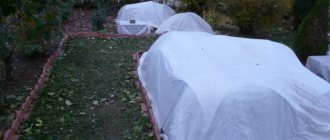History of origin and description of the variety
Rose Scarlett took its first roots in the 20-30s. last century in Great Britain thanks to the famous breeder W. Paul, who took the Wichurana flower hybrid as a basis.
Rose Scarlet forms buds of a rich red color, which over time changes to crimson, and by the end of flowering - cherry. The flower is 6-7 cm in diameter, has a semi-double structure and consists of 25 petals. It blooms in clusters, most often on last year's shoots. Flowers rarely appear on young shoots of the current year, and if they bloom, they are significantly smaller in volume.
Note! The bush has thorns. It reaches 2 m in height and 2.5-3 m in diameter. It blooms for a long time, being replaced by new buds, but the first flowering is the most abundant.
The variety has stable immunity to diseases and can easily withstand heavy rains. A distinctive feature is good winter hardiness, but this applies to mild climates. In harsh winters, secure wrapping is essential.
The flower is not particularly whimsical: it feels good in the sun and in partial shade. Unlike other climbing varieties, it safely takes root in rich and sandy soil.
Questions that arise when caring for this variety
Question No. 1. My rose blooms beautifully, but all the buds are on the upper ends of the branches, and below the bush is completely bare, without leaves. Can this be fixed?
The lower part of the rose is shaded either by the bush itself or by some other object. If the obstacle cannot be removed, then it is better to transplant the rose to a lighted place.
If the bush grows in an open place, then you need to tilt the support so that the crown does not cast a shadow at the base of the bush. Then the leaves and flowers themselves will grow on the shoots to the ground.
Question No. 2. What roses can replace “Paul Scarlet”?
The following climbing roses are similar in color:
- “Amadeus - Amadeus, Cordes, Germany, 2003.
- “Don Juan – Don Juan”, (Italy, 1958), large-flowered climber.
- “Sympathie”, launched in 1964, by Wilhelm Cordes, (Germany), 1964,
- Santana – Santana, Tantau, Germany, 1985,
- Laguna – Laguna, Cordes, Germany, 2004.
Authoritative expert opinion about the rose “Paul's Scarlet Climber”
The British Royal Rose Society compares the rose “Paul's Scarlet Climber” to a climbing floribunda. It is this characteristic that most accurately gives an idea of the appearance of the variety. The rose blooms in tightly closed clusters, which from a distance look like red balls. Densely double flowers consist of more than 30 red-crimson petals. The shape of fully bloomed flowers is cup-shaped. The aroma is not too strong, with notes of honey. The flowers bloom so profusely that the leaves are not visible. Repeated flowering occurs only in regions with warm climates.
(!) A significant problem is low resistance to powdery mildew.
The variety is recommended for single plantings and vertical gardening.
Dr. A. Hessayon. "All about roses."
Features of ground cover roses and their characteristics
In general, ground cover varieties of roses have the following features:
- dense branching of stems widely located in the area;
- rapid growth of stems;
- long lush flowering;
- stable immunity to pests, frosts, diseases;
- do not require pruning or labor-intensive care.
All this influenced the popularity of roses, especially in countries with harsh climates, where not all flowers are able to take root.
Proper and active growth is influenced by the following factors:
- soil composition and slope;
- temperature;
- soil moisture and acidity;
- landing density.
Ground cover roses love light, which promotes abundant and long flowering of buds due to the fact that the nutritional components in the soil quickly penetrate the plant, and moisture does not remain on the petals. Roses are suitable for a soil slope of about 8-10˚ to the west or southeast with the sun in the morning and shade at noon. If the flowers are exposed to the scorching rays for a long time, the color of the buds will become pale and they will quickly fall off.
Note! Poor lighting, planting near trees and walls will slow down root growth, which will lead to weak, thin shoots and possible fungal infection.
Ground cover roses do not like wet soil, which blocks oxygen circulation and leads to hypothermia of the ground in winter. If choosing another planting site is not possible, gravel should be poured into the planting hole. This won't fix the problem, but it will make growing easier.
Regarding the composition of the soil, loamy soil is favorable, as it delivers oxygen and moisture well to the roots of the plant. You should not plant roses in sandy soil, which freezes in winter, gets very hot in summer and practically does not retain nutritional components. To improve the composition, you can add compost with peat, soil and clay.
Does not require pruning or labor-intensive care
The hole for seedlings should be prepared a couple of weeks before planting the flower in open ground.
Note! Before planting a plant, you should clarify its parameters. Dense planting will lead to upward growth, but sparse planting will not give the effect of dense cover.
Before planting, leaves and buds growing below the grafting are removed from the shoots. Broken and weak branches are cut off and the root length is left no more than 20-35 cm. The length of the stem above the ground should not exceed 35 cm. Before planting, the seedlings are disinfected with 5% copper sulfate, and the roots are dipped in a mixture of clay mash and mullein in a 2:1 ratio.
When planting in spring, the shoots are pruned so that strong seedlings have 2-3 buds, while weak ones need 1-2.
Autumn planting takes place from mid-September to the second ten days of October. It is not recommended to do this later, as the roots may not have time to take root and will freeze. It is enough to trim the shoots a little, since all the main manipulations are carried out in the spring.
Important! The holes are dug 50-70 cm deep and 50 cm wide. For mass planting, you can dig a trench.
Despite the fact that ground cover roses are unpretentious, for the correct and healthy formation of the bush you will have to put a little effort into pruning them and periodically fertilizing them with organic fertilizers.
Roses should be watered at least once a week with warm water and poured under the bush, not on the branches. Depending on the size of the rose, you will need no more than 15 liters of water. Young seedlings are watered more often for better rooting.
Resistance to frost allows you not to wrap the shoots. They are able to withstand frosts under snow cover.
Rose care
Caring for ground cover roses is no more difficult than other varieties, in some cases even easier, since they are unpretentious and suitable even for novice gardeners. This type of rose is rarely susceptible to disease
It is important not to forget to water and fertilize in a timely manner. Next, let's look at the rules of care in more detail.
Watering
When caring for roses, it is important to remember one rule: watering must be done in the morning or evening. The fact is that if you water them when the sun is shining brightly, water that gets on the leaves can cause burns.
Regarding the regularity of watering, both its lack and its excess are harmful to roses.
There are no direct recommendations; you need to focus on the condition of the soil. If the top layer has dried out by 3-4 centimeters, you can safely water the plant. Closer to autumn, the frequency should be reduced and the rose should be put into a dormant state
Regarding the regularity of watering, both its lack and its excess are harmful for roses. There are no direct recommendations; you need to focus on the condition of the soil. If the top layer has dried out by 3-4 centimeters, you can safely water the plant. Closer to autumn, the frequency should be reduced and the rose should be put into a dormant state.
Fertilizer
An important point in maintaining the queen of the garden is feeding. During the growing season, fertilizing is done 3 times. The first time is in early spring, after the first leaves appear. To do this, you can use the preparations “Tsitovit”, “Agricola”, as well as other complex fertilizers. When choosing them, you need to look at the composition:
- nitrogen (N) – 1 part;
- phosphorus (P) – 2 parts;
- potassium (K) – 1 part.
About a month later, a second feeding is applied. During the flowering period, it is not necessary to fertilize the rose.
In autumn, the rose is fertilized only with potash fertilizers.
Trimming
In this regard, ground cover roses make life easier for the gardener, since almost all varieties are self-forming and bloom on shoots of different ages. Experts recommend not to prune ground cover roses at all, this will preserve their natural shape, but provided that the plants are planted at an acceptable distance and do not interfere with each other.
Shelter for the winter
Many varieties of ground cover roses do not need shelter for the winter and are able to overwinter under a layer of snow. However, if the winter has little snow or, on the contrary, is too harsh, shelter will still be required. To do this, you need to cover the lashes with spruce branches or throw lutrasil on a wire frame. It is recommended to bend tall ground cover scrubs to the ground. But the bent branches should be placed on a layer of spruce branches, since if they are left on the ground, the plant may rot. The top of the shoots is also covered with spruce branches or lutrasil.
Diseases and pests
Although this type of rose is resistant to pests and diseases, sometimes they can cause inconvenience.
Powdery mildew - manifests itself when there is excessive moisture and mainly affects young leaves, shoots and buds. It is very easy to identify; when infected, a powdery white coating appears on the plant. Leaves may curl and fall off, and flowers may deteriorate.
Black spotting is a fungal disease that appears when there is a lack of potassium, as well as in summer during warm or humid weather. The leaves become covered with dark brown spots, turn yellow and fall off.
Types of ground cover roses
Those interested in ground cover roses should pay attention to the following popular varieties:
Rose Bonica Scarlet
- Rose Scarlet Meillandecor differs from other species in that it grows quickly, is hardy and adapts well to any site. Its small buds of crimson-red shades combine beautifully with dark green leaves. The ground cover rose Scarlet Meyandekor has a small standard that reaches 40 cm. The shape of the bush is fountain-like due to the fact that the shoots fall down under the weight of the buds. Rose Meillandecor blooms throughout the season. The aroma is delicate, but weakly expressed. The rose is resistant to frost and disease.
- The Scarlet Meidiland rose is an excellent choice for landscape design. Maidiland has spreading stems on which are located bright red buds 3-4 cm in diameter. The size of the bush can be controlled by pruning, since its height reaches up to 1 m and its width is 1.5-2 m. Meidiland blooms throughout the summer almost without interruption. The best place for planting is a sunny area. Rose Scarlet Maidiland is resistant to diseases and pests.
- Rose Bonica Scarlet has double red buds consisting of 60-65 petals. Flower diameter is 8 cm. Dark green glossy foliage is disease resistant. Bonica Scarlett reaches a height of 40-70 cm. It blooms profusely throughout the season. In 2015, the variety became a hit and received gold and silver medals at flower shows in Italy and Belgium.
Information
Ground cover rose Scarlet Meyandecor is an incredibly hardy variety that, when growing, covers the soil with a continuous carpet. Small bright scarlet buds up to 3-4 cm in diameter adorn the crown in abundance. Branches often bend under the weight of inflorescences. The petals do not fall off, but dry up right on the bush. Blooms all summer. Used to decorate slopes, flower beds, and as a hedge.
Features of cultivation
Rosa Scarlet Meillandecor holds its shape well and does not need pruning. Loves loose and nutritious loamy soils with aeration, drainage and a neutral or slightly acidic reaction. Planted in warm soil. The seedlings are moistened, freed from packaging and immersed in a hole. Then they are covered with a fertile substrate and watered abundantly. Mineral fertilizing begins a year after planting.
Characteristics
Advantages and disadvantages of the variety
The undeniable advantages of the variety include:
- unpretentiousness and resistance to diseases and pests;
- no need for annual pruning;
- after 2 years it suppresses weeds;
- Easily propagated by cuttings and layering.
For your information! A rose is not just a decoration for the yard. You can make delicious jam from it. The jam will contain many vitamins, iodine, copper, potassium and other useful substances.
The only disadvantages include poor tolerance of frost in harsh regions, since young shoots do not have time to grow stronger and are subject to freezing and are affected by fungal diseases. That is why, after the first October frosts, the bush is cut to 25 cm and unripe shoots are removed. The base of the bush hills up to 15 cm, and when persistent cold weather sets in, the shoots are collected in a bunch, laid on polystyrene foam and covered with roofing material or spruce branches.
If a gardener has a desire to decorate his yard with unusual roses, he should not hesitate: whether or not to buy ground cover rose seedlings. A truly unusual bush will grow that will be the envy of all your neighbors!
Rose Scarlet meilland decor photo description
Ground cover rose Scarlett Meilland Decor. Constantly blooming.
The flower is semi-double (about 30 petals) with wavy petals, thereby creating the effect of a densely double flower. The flowers are bright scarlet, or, as they are characterized, deep red. Flowering is abundant, wavy. During the period of highest decorativeness, the shoots droop to the ground under the weight of flowers. The flowers do not fall off, drying on the stems or forming bright red, decorative fruits, which gives the bush a slight charm. The rose does not require pruning, but by carrying out such manipulations you can restrain the growth force of the bush.
This rose is optimally suited for landscape plantings. Like all ground cover roses, it has such properties as unpretentiousness, tolerance to mechanical damage, excellent growth vigor, bright decorative appearance, long flowering, high disease resistance, and sufficient frost resistance. It should be noted that according to the World Classification this variety belongs to scrubs, but in Ukraine and Russia it is classified as ground cover. It has elegant dark green, shiny foliage. It prefers sunny places, but even in partial shade it feels confident and does not lose its decorative qualities.
Ground cover roses are perhaps the most unpretentious, despite their beauty. The bushes seem to spread along the ground, releasing many shoots covered with hundreds of small flowers of various colors. As a result, the bush becomes like a “flower carpet”. Sometimes the flowering is so abundant that the leaves are not even visible.
Place for planting ground cover roses. First you need to choose a place for a rose or a group of roses. To do this, choose a place that will be visible from the house. A beautiful plant must be visible to be admired. In addition, make sure that the rose is located in a sunny place. She does well in morning or evening sun. If you have a garden in the southern region, then an open sunny place is not entirely suitable for roses, because rose petals will sometimes get burned in intense sun. The place should be ventilated; there is no need to plant roses in low-lying places, as cold air stagnates there and roses often get sick.
Soil for ground cover roses. The best soil for roses is black soil; you can also grow roses on loamy soil. But such soil must be enriched with organic fertilizers. The groundwater level should be below 1 meter. Soil acidity also matters. Rose prefers to grow in slightly acidic soils with a pH of 6.0 -6.5. To acidify the soil, you can add manure or peat. Excess acid is eliminated by ash or liming of the soil.
Planting ground cover roses. The first thing to do is dig a hole about 60cm deep for the rose. Place drainage material at the bottom of the hole. This could be small pebbles, coarse gravel or crushed stone. The drainage layer must be at least 10 cm thick. Then apply natural fertilizer. This could be rotted manure or compost. The layer thickness is at least 10 cm. Manure can be mixed with the fertile layer of soil. Then, on the enriched layer, you need to pour garden soil in the shape of a dome, also at least 10 cm thick. Before planting, make a mash of clay soil and water and lower the rose roots for a few minutes. Then straighten the roots and lower them into the prepared hole. It is best to plant a rose together. One person holds the rose bush so that the root collar is 3 cm below the surface of the ground. Another person carefully covers the plant's roots and lightly compacts the loose soil around the plant. The root collar should be below the surface of the soil after it has been compacted. This planting stimulates the growth of additional stems above the grafting site. After planting, it is necessary to water the bush at the root. If the soil has settled a little, then it is necessary to fill it up. The soil around the seedling needs to be mulched with peat.
Caring for ground cover roses. Caring for roses involves systematically loosening the soil, removing weeds, preventing diseases, fertilizing and pruning. Fertilize seasonally: with nitrogen in spring, phosphorus and potassium in summer. This promotes more luxuriant flowering. Despite their drought resistance, roses require abundant watering during hot and dry periods, especially for young plants. In the first year, young plants should not be allowed to flower early. Until the beginning of August, buds are removed from the bushes. In August, leave 1-2 flowers on each shoot and do not cut them off so that fruits begin to form in the fall. Such plants ripen better and bloom profusely next year.
Pruning roses is a simple procedure, but different groups require a specific approach. The group of ground cover roses is the least susceptible to pruning. The best time to prune roses is spring. As soon as the buds at the bottom of the rose bushes begin to swell, then you can start pruning. When pruning roses in summer, you need to remove faded flowers, thus ensuring re-blooming. In autumn, it is necessary to trim overgrown rose bushes and remove branches affected by fungi. But the main pruning of roses is carried out in the spring, when it is clear which branches have not overwintered and which have swollen buds. First of all, when pruning roses, you need to take into account which shoots the plant produces flowers on: last year’s shoots or this year’s shoots. Next, you should clearly know what you want from this pruning: early and abundant flowering, or a certain shape of the bush. Strong (short) pruning, at the level of 2-4 buds from the base of the shoots, is used, as a rule, when planting seedlings in spring, in the case of rejuvenation of old bushes, or as a last chance for weakened bushes of hybrid tea roses. Medium (moderate) pruning, at the level of 5-7 buds, stimulates early flowering and ensures maximum decorativeness. Light (long) pruning consists of lightly shortening the shoots and is used as summer pruning to remove faded inflorescences. For groundcover roses and some scrub and climbers, this type of pruning is essential, at least for a few years, after which heavy pruning may be necessary to rejuvenate the bush. Combined pruning. Experienced rose growers often use various combinations of the listed types and achieve almost continuous flowering. Combined pruning is the best way to prolong the flowering of floribunda roses.
Covering ground cover roses. In central Russia, roses require shelter for the winter. There is no need to rush to cover roses; roses tolerate frosts down to -7°C well, and they also help plants prepare for winter. Roses should be covered with the onset of persistent cold weather. Before covering, roses are covered with earth. It is not advisable to hill up bushes with peat, sawdust or sand. Spruce spruce branches are best suited for covering roses. It is placed between bushes and on top of plants. After sheltering, wire frames are installed on the bushes. They should be 20–30 cm higher than the plants. Insulation material is laid on the frame, and plastic film is stretched on top, leaving side vents. In the spring (March-April), roses must begin to be ventilated, opening the sides of the frame. It is important to remove the top film as soon as possible, otherwise the temperature underneath it will rise greatly and the buds will begin to grow ahead of time. And since the roots do not yet work in frozen soil, the above-ground part of the plant may dry out. The roses remain under the non-woven material for some time, getting used to the sun.
Propagation of ground cover roses. To preserve varietal characteristics, roses are propagated only vegetatively. At home, the easiest propagation option is cuttings. Cuttings are taken from grown and strengthened bushes after the first wave of flowering. Ground cover roses are easily propagated by layering.
The use of ground cover roses in landscape design. The variety of types and colors makes it possible to use this plant in different parts of the garden. The rose is almost indispensable when decorating the landscape of a garden plot in any of the styles you choose. Roses add charm to any corner of the garden, but also have a flexible nature that allows them to be used in a variety of landscape styles. French regular garden or sentimental country, Victorian or Mediterranean, exemplary version or landscape imitating natural nature. The main purpose of this group of roses is to cover the ground with dense leafy shoots growing horizontally and abundant inflorescences. The use of ground cover roses is largely determined by their growth pattern. These roses, with their long shoots strewn with numerous clusters of inflorescences, can be planted in any corner of the garden. They can be planted in flower beds, rocky areas of the ground, used to decorate slopes and cover hatches. Some vigorous varieties are grown like climbing roses, with their shoots directed upward onto supports. Ground cover roses have many faces and can be used in landscape design for different purposes. The simplest thing is to plant rose bushes on a green lawn. Low-growing groundcover varieties can decorate paths and flower beds as a border. Cascades of blooming ground cover roses cascading from retaining walls, stone stairs, and hills will add originality to a multi-level garden. Low-growing varieties that creep along the ground also look impressive among stones, so they are often planted in rockeries and hills. Since ground cover roses have a very thick and dense bush, they can be grown in containers and flowerpots, or planted on open terraces.
Origin and description of the variety
The Scarlet rose variety was bred more than 100 years ago. It was obtained by the famous rose breeder William Paul, who based it on another hybrid - Wichurana. It is a favorite of many gardeners because its bright red double flowers, collected in clusters of inflorescences, create a colorful touch in any design.
At the same time, the variety is unpretentious, frost-resistant and does not require pruning. It blooms luxuriantly and abundantly, bright flowers are favorably emphasized by dark green glossy foliage. Over time, the flowers change from bright crimson, almost scarlet, to cherry. The bush has good growth vigor.
Varieties
Selection does not stand still, and today there are already several varieties of the Scarlet variety with spectacular red flowers and dark green glossy foliage.
Meillandecor
This variety is a scrub (semi-climbing rose), has a fountain-like appearance, and is sometimes classified as a groundcover. Up to 10 scarlet semi-double flowers with a diameter of 3–4 cm are formed on each peduncle. It blooms continuously all summer and autumn.
The Scarlet Meillandecor variety was bred in France in 1987 and is actively used in landscape design. The bush has great vigor and grows up to 140 cm in height and 150–185 cm in width. During flowering, the shoots droop under the weight of the flower clusters. The variety also has other names - MEIkrotal, Scarlet Meidiland.
Ground cover
Scarlet Bonica is a new product and is distinguished by the rich red color of its buds. This is a floribunda, which we classify as a ground cover variety. It has high frost resistance, disease resistance and long flowering.
It was bred by the famous French nursery “Meilland” in 2015. The bushes are compact, 50–100 cm high. Scarlet flowers with a diameter of 5–10 cm are collected in small inflorescences (3–5 pieces). The official name is Scarlet BONICA (AM 210, Canyon Road, MEIscarlebo).
Paul
This is a climbing rose, which was the very first to be bred in 1916 and has the official international name Paul's Scarlet Climber. Here it is also found under the name Paul Scarlet. It has bright red flowers with a diameter of about 7 cm, collected in brushes of 3–5 pieces. The variety blooms very luxuriantly, but only once a season, usually in early summer.
Repeated flowering is absent, and if it occurs, it is only in the southern regions and very weakly. This representative of roses has canes that grow up to 3 m; it is used for landscaping walls, fences, gazebos and arches. The variety is classified as a climbing floribunda. It is unpretentious, can grow on poor soils, and is winter-hardy.
The Scarlet Hit variety (Scarlet, POULmo, Scarlet Hit, Ruby Wishes) was bred in Denmark in 1987. Refers to patio roses (or miniflora), being, in fact, low-growing floribunda roses. Their height is only 40–60 cm, so they are excellent for landscaping borders, flower beds, and creating low trunks. Small ruby roses (about 4–5 cm) bloom continuously and fall off on their own after flowering.
Please wait. The request is being processed...
USDA Zone Six
The maximum possible winter temperature is up to -23C (Europe)
Disease resistance:
| Weak, the plant needs constant prevention: | + |
| Average, gets sick in unfavorable years: | ++ |
| Very good, practically does not get sick: | +++ |
Rain resistance:
| Weak, flowers do not open when it rains: |
| Medium, some flowers are damaged: |
| Very good, the flowers are not spoiled by rain: |
Bloom:
| Single flowering: |
| Reblooming: |
| Continuously blooming: |
| Rose Modern Shrub, Cleveland County Rose Society, USA (2000) Rose Modern Shrub, Great Lakes District, USA (1999) |
| Modern Shrub | ||
| Health, vigor, adaptability and hardiness are the hallmarks of this variety. The flowers are small, bright red, with wavy petals. The bush is fountain-shaped, the shoots often droop under the weight of the flowers, which are round in shape. The flowers do not fall off, but dry up right on the bush. This rose does not require pruning, although neat freaks may want to trim off faded flowers. The foliage is dark, shiny, and disease resistant. Blooms continuously all summer and autumn. (ARE) The Meidiland series is an excellent choice for landscape planting. Scarlet Meidiland has a spreading bush covered with clusters of bright red flowers. The size of the bush can be controlled by pruning. Grows best in full sun. Resistant to diseases. It blooms almost continuously all summer. (Oliver) | Photo Rosebook Uploaded to the site: admin | |
| Color: | scarlet | |
| Number of flowers per stem: | 5-10 | |
| Aroma: | ? | |
| Flower size: | 3-4 cm | |
| Average number of petals: | 25 | |
| Height: | 90-140 cm | |
| Width: | 150-185 cm | |
| USDA: | Sixth zone | |
| Resistance to powdery mildew: | +++ | ? |
| Black spot resistance: | +++ | ? |
| Rain resistance: | ? | |
| Bloom: | ? | |
| Bush shape: | Flower: | |
| Bordurella x Clair Matin |
Features of planting and growing
Scarlet roses prefer sunny places, although they can grow in partial shade. There should be no cold winds at the landing site. Like all roses, they grow well in nutritious and well-permeable soils with an acidity of 5.6–7.3 pH.
Roses are planted when the earth warms up enough, approximately in May. The ideal air and soil temperature for roses is the range +17…+20°C. In this mode, the bushes will take root and grow well. In the southern regions, roses can be planted in the fall in warm, dry weather, when air humidity is about 80% and the temperature does not drop below +5...+10°C at night.
The planting hole is dug of such a size that the seedling can be freely placed in it and its roots can be straightened. If necessary, you need to make drainage from crushed stone or sand, since roses do not tolerate stagnant water. For planting, it is recommended to make the following nutritious soil mixture: mix manure, fertile soil, sand and peat in a ratio of 3:2:2:1.
Roses need about 600 mm of rainfall annually. They do not like strong summer heat (over +30°C), so they require watering on hot days. Scarlet varieties are considered winter-hardy, but in harsh winters it is better to cover them.
Flower propagation
The easiest way to propagate Scarlet is by layering. Thanks to the long climbing shoots of the plant, the process is carried out without unnecessary difficulties.
Layers are laid in the spring, in May. For the winter they are covered with spruce branches, and with the onset of the new season they are separated from the mother bush and replanted.
One or more shoots are selected for rooting. Dig a deep groove 10 cm deep next to the bush and place a whip in it so that 1-2 buds are at the bottom and the same number on top. The whip is pinned down, covered with earth and the humidity level is monitored during the summer.
Home care
All Scarlet roses are considered unpretentious, but this does not mean that they do not need to be looked after.
Watering
Scarlet rose bushes are watered as the soil dries out (about once a week). The bushes are watered infrequently, but abundantly - about 10 liters of liquid for 1 adult plant. Watering should be done in the morning or evening. In hot weather, watering should be done more often: up to 3 times every 7 days. The stream of water from the hose should not be strong so as not to erode the root system of the plant.
It is better to water the ground around the bush so that splashes do not fall on the leaves and flowers. Water for irrigation should be at room temperature. In a large rose garden in the summer, you need to install an irrigation system with a sprayer. In the autumn, watering is reduced so as not to provoke the appearance of fungal diseases, but the roots should not dry out.
Fertilizer application
When planting rose bushes, it is necessary to fertilize. The drug “Cytovit” is perfect for this purpose.
Adult bushes should be fertilized at least 3 times during the warm period:
- The first feeding is carried out in April, approximately 14 days after the leaves appear. Nitrogen fertilizers are used for this purpose. A slurry made from manure or bird droppings works well. To do this, the manure (droppings) is dried, then diluted with water in a ratio of 1:4, and allowed to brew for a couple of days. After this, 1 liter of this infusion is diluted with liquid in an amount of 10 liters.
- The second time , fertilizing is applied from the end of May to the beginning of June, 21–28 days after the first fertilizing. For this, complex fertilizers are used. A mixture of 1 part potassium, 2 parts phosphorus, 1 part nitrogen works well. You can use ready-made complex fertilizers such as “Kemira Universal”.
- The third feeding is carried out in early September. Phosphorus-potassium fertilizers are used for this purpose.
Trimming
On the new shoots of the current year, the Scarlet rose forms only a few buds, so most of the flowers are formed on the stems of previous years. Florist experts do not recommend pruning before the onset of winter. In autumn, pruning of old shoots 5–6 years old is allowed.
But at the beginning of spring, before the buds awaken, the bush must be pruned after cleaning the shelter for the winter. All damaged and dried branches are cut back to the healthy part. In the summer, formative pruning is carried out as necessary. In this case, shoots that have already bloomed are cut off.
Transfer
Sometimes, when redeveloping a site, it is necessary to transplant an adult plant from place to place. This procedure is best done in spring or autumn. First you need to choose a place with optimal conditions and prepare a planting hole (as for planting a new seedling).
Before transplanting, the plant needs to be watered and the branches tied to make it easier for you to approach the bush. If this is done in summer, then the rose bush should be pruned, leaving only 40–50 cm in height, removing immature shoots and buds.
An adult plant is dug up, preserving the largest amount of earthen coma, i.e., using the transshipment method. To do this, dig up the bush around the perimeter, take it out of the ground and then place the roots with a lump of soil in polyethylene. Roots that are too long to interfere with digging will have to be cut off.
After this, they transfer the plant to a new planting hole, fill it halfway with soil, remove the film from the coma, place the bush in the new hole, water it, fill it with the remaining soil and water it again. After all the moisture has been absorbed into the ground, the soil around the bush is compacted. For better engraftment of the root system, you can use the drug “Zircon”.
How to plant correctly in open ground
To successfully grow any variety of Scarlet rose, it is important to plant it correctly.
The procedure is typical for planting any climbing varieties, but has its own nuances. Ground cover rose Scarlett takes root best as seedlings obtained by cuttings, rooting cuttings or dividing the bush. Since the variety is a hybrid, it is recommended not to plant seeds.
Scarlet can be planted in spring and autumn, but it is preferable to do this in May, when the threat of frost has passed. Young bushes planted in the fall may not have time to take root before the cold weather.
Selecting a location, preparation
The climbing rose Scarlett feels better in well-lit areas, protected from gusts of wind and drafts. The planting site should be on a slight hill to avoid groundwater being close to the roots.
This rose requires soil that is easily permeable to air and moisture, nutritious, with an acidity level of 5.6–7.3 pH.
Attention! The soil must be dug up, adding sand if necessary and enriching it with organic matter.
The roots of purchased seedlings are inspected a day before being placed in the selected area, non-viable ones are cut off, and the sections are dipped in coal. After this, they are placed in water until planting.
Step by step landing procedure
Planting of seedlings is carried out in a certain sequence. They act like this:
- Dig planting holes, leaving a distance of at least 60 cm between them.
- Place drainage at the bottom of the hole and cover it with earth.
- The seedling is lowered into the hole, carefully straightening the roots.
- The hole is filled in, compacting the soil.
- The rose is watered with settled water.
After planting, it is advisable to mulch the soil around the flower.
When planting, be careful not to damage the roots.
Difficulties in growing
When growing Scarlet roses, if agricultural practices are violated or unfavorable external factors occur, you may encounter some difficulties.
So, this rose may develop the following pests and diseases:
- Powdery mildew. It is detected by the appearance of whitish spots on leaves and stems. To combat such a nuisance, you should cut off and dispose of the damaged parts, and then treat the bush with copper sulfate or Bordeaux mixture.
- Black spot. The disease can be identified by brown spots on the leaves and branches. To eliminate the problem, the affected areas should be removed and burned, followed by spraying with Bordeaux mixture.
- Bacterial cancer. A sign of this disease are brownish spots that become larger in size over time. Unfortunately, in this case, the bush needs to be dug up and disposed of, since there are no effective remedies against this disease. For preventative purposes, to prevent the occurrence of this disease, rose seedlings should be treated with copper sulfate before planting in a permanent place.
- Rust. It appears as rusty seals on the bottom of the leaves. For control, spraying with Bordeaux mixture or Fundazol solution is used. For the purpose of prevention, treatments are carried out with immunomodulatory drugs and systemic fungicides.
- Spider mite. This pest can be detected by the appearance of a thin cobweb on the leaves, as well as light spots on them. You can get rid of spider mites using insecticidal preparations "Aktara" or "Fitoverm". For preventive purposes, you can treat the bushes with an infusion of onion peels. The smell of marigolds, calendula, and tansy planted nearby will also repel these pests.
Scarlet roses are unpretentious, easy to care for and at the same time extremely beautiful. In some varieties, their bright red flowers delight with their bloom throughout the summer and even in the fall.
Diseases, pests and ways to combat them
The Scarlet variety has developed immunity to most diseases. Main insect pests:
- spider mite;
- aphid;
- scale insect
Special products - insecticides - are purchased in the store, and the plant is completely treated with them.
Scarlet climbing rose is an amazing plant that captivates every gardener at first sight. You can choose any variety of this variety, or you can grow several or even all of them on your plot. The result will be amazing in any case.











